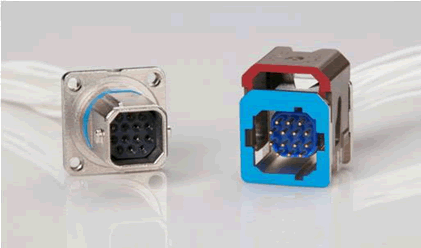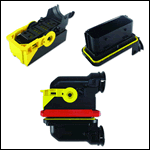How to Specify Nanominiature Connectors
Nanominiature connectors provide an ideal solution for challenging wiring systems in the constantly evolving aerospace industry. Here, Radiall offers tips on how to specify the connectors for these applications.

Radiall’s QuickFusio nanominiature connector
To address the challenges airframers experience in the civil and military aerospace industry, a new format for multipin connectors was introduced. The nanominiature connector is a lightweight, compact solution that reduces the overall space required and uses smaller cable gauges than traditional connectors. These nanominiature connectors provide the constantly evolving aerospace industry an ideal solution for challenging wiring systems.
How did nanominiature connectors rise in the aerospace industry? Several years ago, when new generations of aircraft were being manufactured, there was a shift in the civil aerospace industry, and electrical functions overtook hydro-mechanical functions. This evolution required a change in the electrical architecture of the aircraft. Nanominiature connectors were proven to be an effective solution that allowed several voltage buses to cover all types of electrical equipment in this new electrical architecture.
Another major shift in the aerospace industry was the implementation of EWIS standards, which require greater reliability and more safety features on aircrafts. Nanominiature connectors can help segregate critical and non-critical electrical buses on the aircraft and improve overall safety by protecting these buses against EMI.
Achieving weight savings in aircraft to reduce fuel consumption has also presented many challenges in previous years. The lightweight design of nanominiature connectors provides airframers this benefit. By reducing the weight of connector components, there is a decrease in the overall cost of the aircraft.
How do nanominiature connectors contribute to weight savings?
- Nanominiature connectors provide airframers more flexibility if they choose remote electrical architecture systems, because they allow the use of smaller wire harnesses.
- Nanominiature connectors allow airframers to optimize connector size and weight if they choose to increase voltage to lower current. The combination of a smaller connector and smaller wire gauges decreases the overall weight of the aircraft.
What challenges do nanominiature connectors experience in this environment? They need to be lightweight and compact for new aircraft platforms, prove cost-effective, and provide the same level of performance as traditional connector solutions. Most importantly, aircraft manufacturers want cost-effective connector components that contribute to the reduction of the overall cost of ownership.
What is expected from nanominiature connectors?
- A quick and easy-to-mate and -terminate connector, which can reduce installation time and cost
- Significant weight savings in comparison to traditional connector solutions
- A versatile range with modular components to reduce part numbers and cost diversity
- When applicable, standardized contacts and accessories that reduce risks and limit qualification costs to integrate
- Non-removable parts that lower FOD cost and the overall cost of ownership
Nanominiature connectors are essential for designing an electrical wiring interconnection system in any aircraft. The compact design provides the aerospace market with reliability, safety, functionality, and cost optimization. They complement existing harness solutions and provide flexibility without compromising the high performance required in the aerospace industry.
[hr]
This article was contributed by Radiall.






